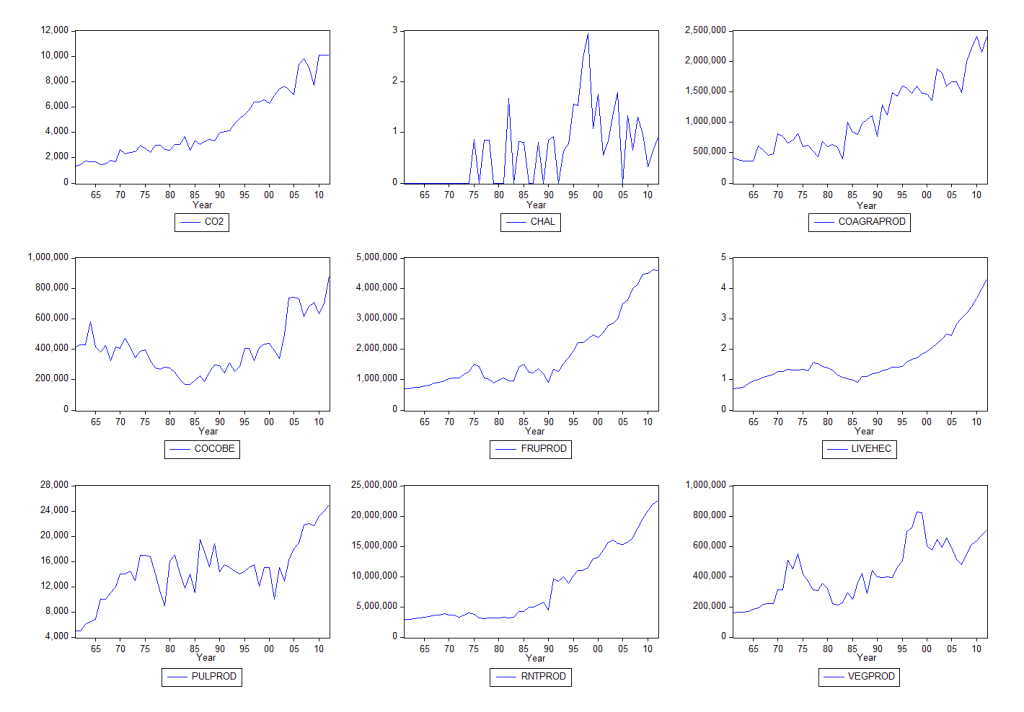Is there a relationship between carbon dioxide emission and agriculture?
According to the Earth System Research Laboratory 2015, the growth rate of carbon dioxide has increased over the past 36 years (1979-2014), averaging about 1.4 ppm per year before 1995 and 2.0 ppm per year thereafter. The increasing rate of greenhouse gas emissions, especially carbon dioxide has received global attention as outlined in the Sustainable Development Goal (SDG) 13 which focuses on actions that help mitigate climate change and its impact. However, approaches toward reducing greenhouse gas effect through emission-reduction policies have been skewed toward the energy and industrial sector. Current research shows that the global agricultural output has increased with increasing population since the middle of the 20th century. Therefore a doubling in the global food demand to meet the rapidly growing population poses threat to agricultural and environmental sustainability. Agriculture has been identified as one of the main sources of greenhouse gas emissions (GHG) due to the introduction of unsustainable agricultural practices in order to boost productivity, which leads to food security.

Fig. 1. CO2 – Carbon dioxide emissions (Kt), LIVEHEC- total Livestock per hectare of agricultural area (No/Ha), CHAL – annual change of Agricultural area (%), RNTPROD – total Roots and Tubers Production (Tons), VEGPROD – Total Primary Vegetables Production (Tons), PULPROD – Total Pulses Production (Tons), FRUPROD – Total Fruit Production excluding Melons (Tons), COAGRAPROD – Total Coarse Grain Production (Tons), and COCOBE – Cocoa beans Production (Tons).
Agriculture is one of the major drivers in Ghana’s growing economy. For example, crop production, forestry, fisheries, cocoa production and livestock production accounted for 66.2%, 12.2%, 7.3%, 8.2% and 6.1% of agricultural GDP as at 2010. Out of 3,396,000 hectares of the area designated for starchy and cereal staple production, maize, cassava, yam, plantain, sorghum, cocoyam/taro, rice and millet production occupies 992,000 hectares, 875,000 hectares, 385,000 hectares, 328,000 hectares, 253,000 hectares, 205,000 hectares, 181,000 hectares and 177,000 hectares respectively. With regards to industrial crop production; cocoa, oil palm, tomato, seed cotton, other vegetables, pineapple and others (coconut, banana, kola, rubber and tobacco) production occupies 1,600,000 hectares, 360,000 hectares, 50,000 hectares, 20,000 hectares, 20,000 hectares, 328,000 hectares and for 2,000,000 hectares, summing up to 4,060,000 hectares of area in accordance with Ministry of Food and Agriculture statistics in Ghana. In addition, livestock production increased from 1999 to 2010. For example, cattle production rose from 1,288,000 heads to 1,454,000 heads, sheep production rose from 2,658,000 heads to 3,779,000 heads, goat production rose from 2,931,000 heads to 4,855,000 heads, pig production rose from 332,000 heads to 536,000 heads, and poultry production rose from 18,810,000 birds to 43,320,000 birds respectively.

Fig. 2. ARDL-Autoregressive distributed lag. Interpretation: ARDL cointegrating relations shows that the relationship between carbon dioxide emissions and agriculture in Ghana decreases periodically which may die over-time.
Against the backdrop, the study analyzed the relationship between carbon dioxide emissions and agriculture in Ghana using econometric techniques like vector error correction model and autoregressive distributed lag model. Econometric techniques are modern statistical methods that help to analyze the cause-effect of past data variables in order to improve future policies. The study employs ten data variables that constitute the majority of Ghana’s agricultural sector, namely; livestock, annual change of agricultural area, roots and tubers, total primary vegetable production, total pulses production, total fruit production excluding melons, total coarse grain production, and cocoa bean production from 1961 to 2012.
Results from the study shows that carbon dioxide emissions affect the percentage annual change of Agricultural area, coarse grain production, cocoa bean production, fruit production, vegetable production and the total livestock per hectare of the agricultural area in Ghana. Nonetheless, the relationship between carbon dioxide emissions and agriculture in Ghana decreases periodically, which may die over-time. It is recommended that the integration of climate change measures into the national strategies, policies and planning will strengthen the country’s effort to achieving a sustainable ecosystem.
Samuel Asumadu-Sarkodie and Phebe Asantewaa Owusu
Sustainable Environment and Energy Systems
Middle East Technical University, Northern Cyprus Campus Kalkanli
Guzelyurt, Turkey
Publication
The relationship between carbon dioxide and agriculture in Ghana: a comparison of VECM and ARDL model.
Asumadu-Sarkodie S, Owusu PA.
Environ Sci Pollut Res Int. 2016 Feb 22
One Response to Is there a relationship between carbon dioxide emission and agriculture?
Leave a Reply
You must be logged in to post a comment.













Thanks to Atlas of Science for the invitation given us to published our research in a layman’s perspective.